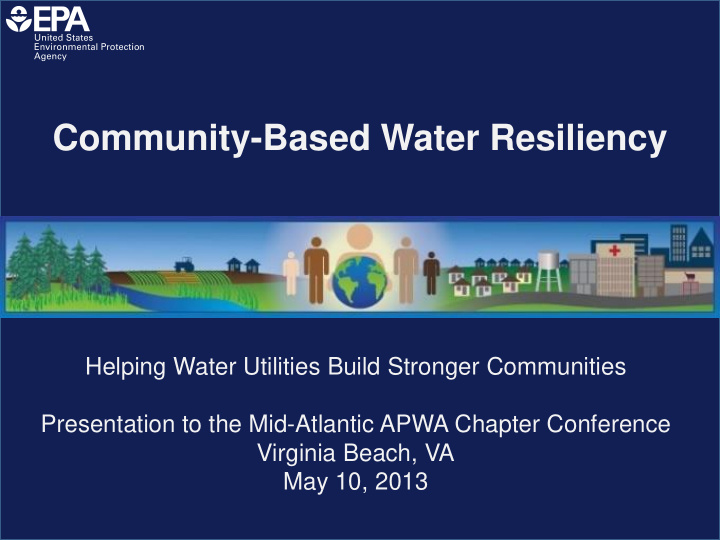



Community-Based Water Resiliency Helping Water Utilities Build Stronger Communities Presentation to the Mid-Atlantic APWA Chapter Conference Virginia Beach, VA May 10, 2013
What is Community-Based Water Resiliency 2
CBWR Provides Resources to Help Increase Preparedness & Resiliency CBWR can help: • Bring utilities and publics works together with: – Emergency Planners and First Responders – Business Community and Members of the Public – City/County Managers – Public Health Officials • Increases preparedness at the community level by: – Increase understanding of critical interdependencies – Highlighting multiple benefits of preparedness – Improving integration of the Water Sector into community emergency preparedness and response efforts 3
Why Involve the Entire Community? Water service interruptions can have serious economic, environmental, psychological, and public health consequences. Resilient communities can significantly reduce these risks at negligible cost. • All emergencies & responses are local, all threats & vulnerabilities unique • Public works departments play a critical role during water emergencies • Water sector personnel need to: – Collaborate with interdependent sectors – Coordinate with law enforcement, community leaders, business leaders, and the general public • Communities need to : – Understand interdependencies & how a water emergency will affect them – Access tools and resources that speak to their roles and responsibilities in advance of a crisis 4
Benefits to a Community In a day without water, how would you meet the needs of: Sanitation, Business Interests, Environmental Protection, and Hospitals/Dialysis Services CBWR helps communities to: • Recognize importance of water and organizational reliance on water • Forge partnerships between water utilities and their community • Clarify organizational roles and responsibilities during a disaster • Increase community preparedness for water emergencies • Reduce impacts of water service interruptions 5
Self Assessment 5 Stakeholder Groups & Numerous "User Roles” Example: Emergency Services Sector roles include • Law Enforcement • EMS • Hazardous Materials • LEPC and, • Emergency Manager among others 6
Resource Toolbox The Toolbox contains stakeholder specific resources to help them prepare. Available resources include webinars, presentations, case studies, professional training courses (ICS/NIMS) and many others. 7
Water Resiliency Action Planner (WRAP) Kit • Provides users with step-by-step process for planning a water emergency discussion, and covers: – Expectations – Roles and responsibilities – Capabilities and limitations – Planning, hosting and follow-up actions • Includes sample: – Agendas – Invitations – Suggested participants – Logistical templates and scripts for recruitment
CBWR Pilot: St. Clair County, Michigan • Participants: Water Utility, Neighboring County Emergency Managers, Police and Fire, Public Health Department (Local and Canadian), Schools, Hospital, State Primacy Agency, EPA Regional Water Contact • Outcomes: Multi-Phase work plan including training, vulnerability assessments and continued tabletop exercises • Lessons Learned: • Water Utilities : • Determine flow capabilities and exercise interconnections • Set priorities for water provision • Emergency Management • Post County Hazard Mitigation Plans & Strengthen public/private sector COOP • Conduct water audits • First Responders • Include details of alternate water supplies in emergency response plans • Implement long-range planning • Full Summary Review Available Online 9
All-Hazards Disaster Resiliency Infrastructure failures are not a matter of “if” they are a matter of “when”…we all need to be prepared and plan ahead. The Water Sector faces numerous threats: • Infrastructure Failure • Natural Disasters • Hurricanes, Tornadoes etc . • Contamination • Accidental, Intentional or Terrorist CBWR can help you prepare!
Using CBWR to Achieve All-Hazard Disaster Preparedness CBWR can help you: • Coordinate with emergency planners • Strengthen emergency response plans • Increase citizen understanding of potential impacts from a service interruption • Support business and community services to factor water service interruptions into emergency plans and, • Ensure hospitals and critical facilities have alternate water supply 11
Upcoming CBWR Training • New Jersey – June 12 • New York – Mid June • Other Locations to be Announced Soon 12
Don’t Forget About Other EPA Resources to Improve Resiliency http://water.epa.gov/infrastructure/watersecurity/ 13
Federal Disaster Funding for Water/Wastewater Utilities 14
Climate Ready Water Utilities Initiative 15
Download The Community-Based Water Resiliency Tool Today! Please visit: http://www.epa.gov/communitywaterresiliency Community-Based Water Resiliency Project Lead: Nushat Thomas 202-564-4674 T homas.nushat@epa.gov 16
Recommend
More recommend